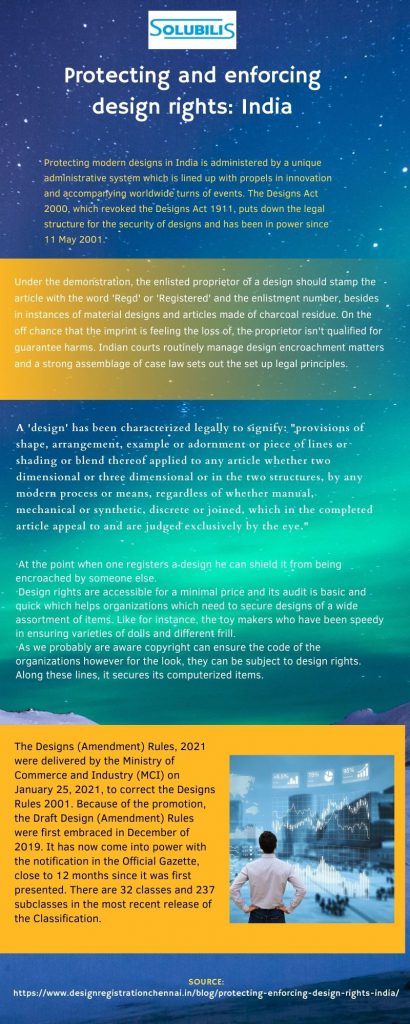TALK TO EXPERTS
Protecting modern designs in India is administered by a unique administrative system which is lined up with propels in innovation and accompanying worldwide turns of events. The Designs Act 2000, which revoked the Designs Act 1911, puts down the legal structure for the security of designs and has been in power since 11 May 2001.
The demonstration not just accommodates least principles of assurance for modern designs (as thought about in the World Trade Organization Agreement on Trade-Related Aspects of IP Rights (TRIPs)), yet additionally adjusts to worldwide patterns in design organization. Related to the Designs Rules 2001 (as altered in 2008 and 2014), the demonstration streamlines out the procedural parts of enlisting and handling design applications.
The 2014 alteration to the Designs Rules acquires ‘little element’ as another class of candidate notwithstanding regular people. India is likewise party to different global settlements which ensure worldwide designs, including the Paris Convention and TRIPs. In spite of the fact that India isn’t a signatory to the Locarno Agreement, the order of articles to which a design is applied depends on the International Classification of Industrial Designs according to the arrangement.
Enforcement
The enrolled proprietor of a design partakes in the restrictive right to apply a design to the article in the class where the design has been enlisted. An enrolled proprietor can document an encroachment suit. An enrolled design in India can be upheld via a common activity. The cures against encroachment incorporate break and long-lasting directives, just as harms.
A common activity authorizing an enrolled design can be documented under the steady gaze of the locale court where the respondent lives or directs business or where encroachment has occurred. As well as utilizing the guard of non-encroachment, the infringer can utilize the protection of deficiency of the design because the design needs oddity, is vague from a known design or contains shameful matter. In the event that the protection of deficiency is utilized in a common activity, the area court no longer has locale and the suit is moved to the high court with ward over that region court.
Under the demonstration, the enlisted proprietor of a design should stamp the article with the word ‘Regd’ or ‘Registered’ and the enlistment number, besides in instances of material designs and articles made of charcoal residue. On the off chance that the mark is feeling the loss of, the proprietor isn’t qualified for guarantee harms. Indian courts routinely manage design encroachment matters and a strong assemblage of case law sets out the set up legal principles.
Ownership changes and right transfers
As per Indian design law, the squarely in an enlisted design can be moved via task, arrangement, transmission and authorizing. Enlistment of title dependent on task should be documented with the Design Office within a half year of execution of the task instrument. A further augmentation of a half year can be looked for. It is basically impossible to broaden this time past one year after the powerful date of the instrument. The law likewise accommodates the record of a license, which should be done within a half year of issue. Just an enlisted license or an enrolled task in regard of an enrolled design is permissible as proof under the watchful eye of the courts or in some other procedure, and along these lines such instrument should be enlisted with the Design Office.
What is registered deign?
A ‘design‘ has been characterized legally to signify: “provisions of shape, arrangement, example or adornment or piece of lines or shading or blend thereof applied to any article whether two dimensional or three dimensional or in the two structures, by any modern process or means, regardless of whether manual, mechanical or synthetic, discrete or joined, which in the completed article appeal to and are judged exclusively by the eye.”
This definition is comprehensive and all legal prerequisites should be satisfied by the component to establish a design under the demonstration. The key prerequisite is the component’s capacity to engage the eye. This infers that the component should be apparent on the article and have tasteful or creative legitimacy or visual allure.
Albeit the curiosity necessity is supreme, the demonstration gives an exemption as a six-month effortlessness period in the event of revelation of the design prior to documenting. The elegance period is accessible just if:
- the design is unveiled, utilized or distributed in a show advised by the public authority;
- the exhibitor displaying the design or article gives earlier notification to the regulator of designs; and
- The application for the design is documented within a half year of the primary show of the design.

Benefits of design registration
- At the point when one registers a design he can shield it from being encroached by someone else.
- Design rights are accessible for a minimal price and its audit is basic and quick which helps organizations which need to secure designs of a wide assortment of items. Like for instance, the toy makers who have been speedy in ensuring varieties of dolls and different frill.
- As we probably are aware copyright can ensure the code of the organizations however for the look, they can be subject to design rights. Along these lines, it secures its computerized items.
- It is likewise extremely accommodating for quick businesses like the design business. The speed with which the design rights give a solution for encroachment can help the designers in securing their items in the key business sectors.
Abstract of design amendment rule 2021
The Designs Act of 2000 was passed by Legislature to guarantee that the Indian Designs Law follows the TRIPS Agreement after India turned into a “part State” of the WTO in 1995. The Act intended to work on the viability of existing enactment by incorporating changes welcomed on by progresses in science and innovation, and empowering design activity by giving proper protections to Industrial Designs. The Central Government has the position to make rules under Section 47 of the Act[i] to completely authorize the Act’s arrangements.
The Designs Act of 2000 and ensuing Designs Rules, 2001, which cancelled the past Act of 1911 and became effective on May 11, 2001, manage the library and insurance of modern designs in India. Designs (Amendment) Rules 2008, Designs (Amendment) Rules 2014, and Designs (Amendment) Rules 2021 all changed the Design Rules of 2001.
The Designs (Amendment) Rules, 2021 were delivered by the Ministry of Commerce and Industry (MCI) on January 25, 2021, to correct the Designs Rules 2001. Because of the promotion, the Draft Design (Amendment) Rules were first embraced in December of 2019. It has now come into power with the notification in the Official Gazette, close to 12 months since it was first presented. There are 32 classes and 237 subclasses in the most recent release of the Classification.
